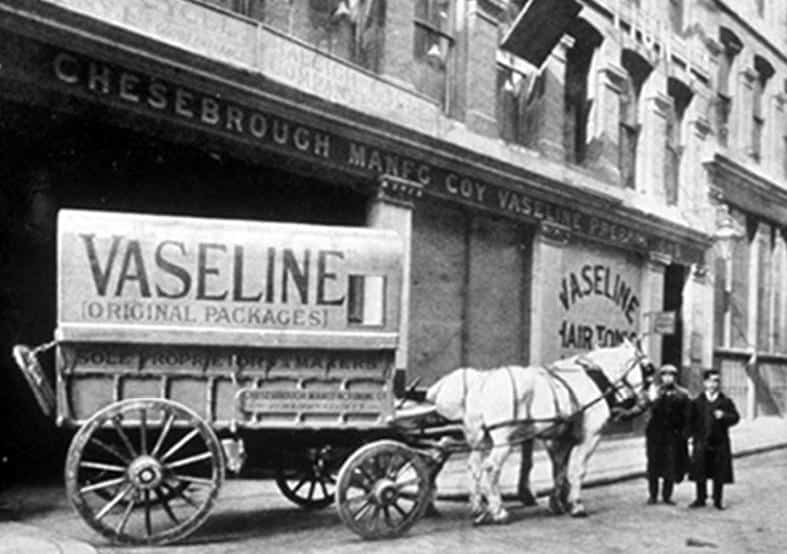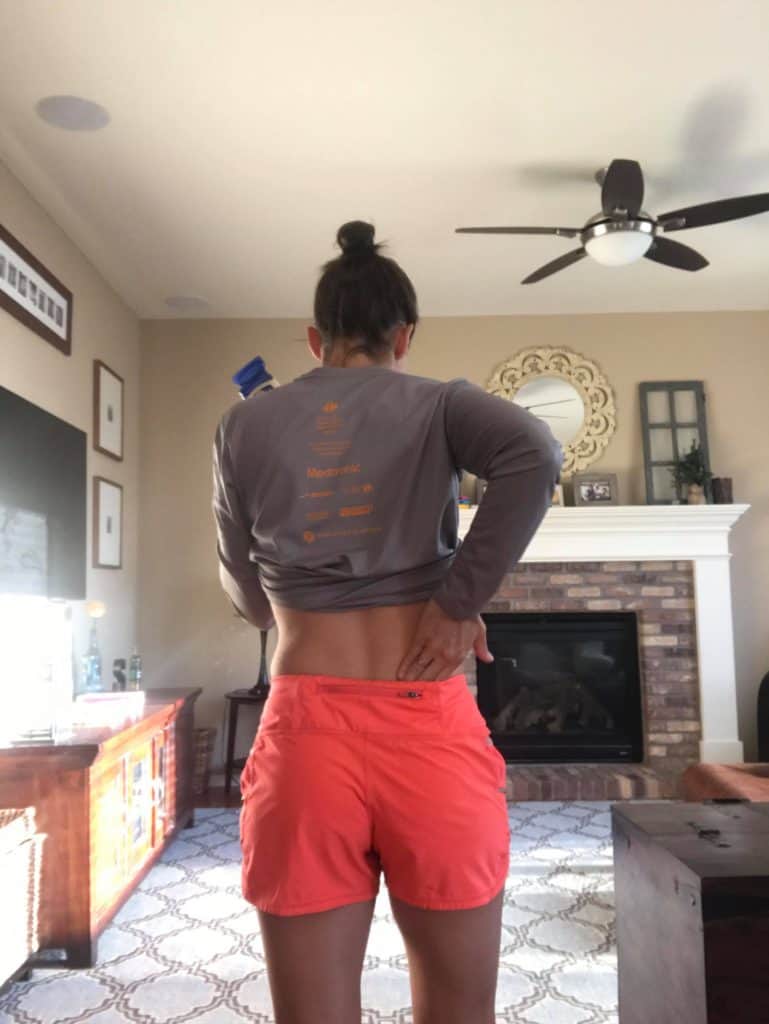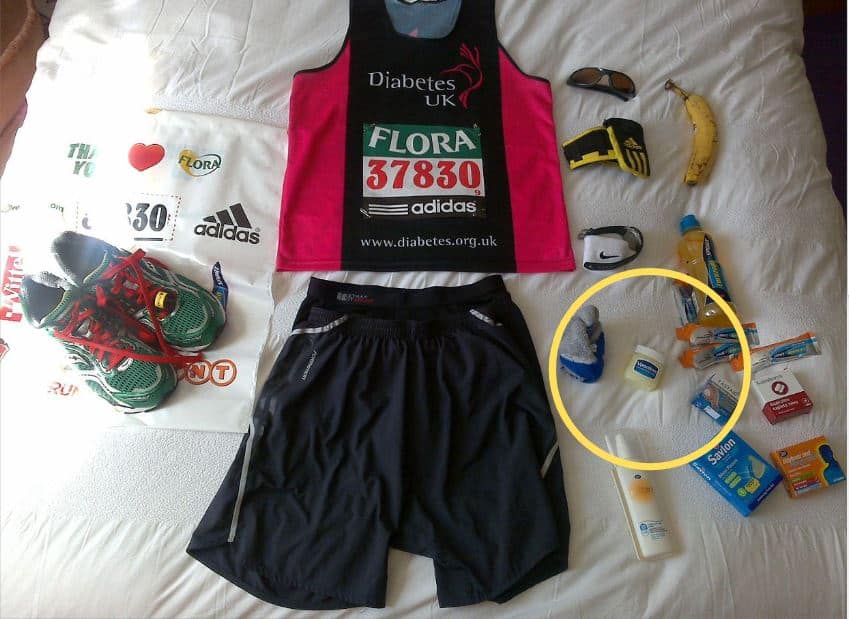I will always remember how at one of my earliest races, probably the Bolder Boulder 10k, volunteers were walking around with a big wooden board of translucent goo smeared on it. Right as I was wondering what the heck it was, I saw some guy swipe his hand through the goo and start applying it under his arms. “Gross!” I thought…realizing then that it was community Vaseline. At the time, I didn’t really understand the purpose of this apparent race staple. Once I started training for marathons, however, it all became crystal clear.
How can I stop chafing when I run? Chafing can be an issue for runners training for a marathon. Any time a person sweats and skin rubs against clothing or other skin, chafing can occur. With repeat friction, this can cause redness and irritation of the skin and sometimes even bleeding. Vaseline acts as a barrier, preventing chafing from happening while running.
The question is, does Vaseline need to be part of your marathon training gear? Let’s find out.

Vaseline and Its Uses
Vaseline is a brand name of petroleum jelly, much like how many people call all facial tissue “Kleenex.” And just in case you’re wondering if it was invented for us marathon runners, the answer is no. (But read on to find out about a product that was!)
In 1859, Robert Chesebrough patented the process of extracting petroleum jelly from an oil rig pump residue called “rod wax”. He began selling it as a medicinal product and branded it with the Vaseline name in 1870. Its specific use was to heal cuts and burns, which it is still used for today. The brand is going strong and is used for various purposes on the human body including:
- Skin Injuries – to reduce scarring and speed up healing time by keeping the wound moist.
- Sunscreen – though not the best protection against the sun’s harmful rays, it’s better than not using anything at all.
- Prevent Moisture Loss – since the skin doesn’t readily absorb petroleum jelly like lotion, it can lock in moisture.
- Skin Lubrication – when the skin is chapped, dry, or peeling, Vaseline works well to soothe the skin in a non-irritating way.
- Skin Care – petroleum jelly is often used in skin lotions and cosmetics.
- Hair Grooming – it is often an ingredient in something such as pomade to style hair.
- Runners – this one’s for you – Wound Prevention – If you know you’re going to be sweating or have a runny nose, Vaseline can be applied beforehand to prevent skin irritation or breakage. This is exactly the way in which runners can utilize it.

Petroleum Jelly is recommended by the American Academy of Dermatology and is considered very safe for external skin use. It’s definitely something that marathon runners can benefit from having in their medicine cabinet.
Why Marathon Runners Use Vaseline
With its variety of uses, it’s not at all surprising that Vaseline has continued to be a popular medicinal product for over 150 years. Though runners tend to get excited about all of their fancy equipment…Garmin watches, wireless headphones, hydration packs…just to name a few, sometimes it’s the littlest things that can make or break a run. Vaseline is one of those things.
I know it doesn’t look or sound exciting, but most marathon runners are so thankful once they’ve added Vaseline (or similar) to their list of necessary gear. The cost is so little but can really make a big difference. Here’s why.
Sweat and Rubbing Don’t Mix
Runners sweat. A lot. And if you live in a place like Texas or Florida, you know all too well what it feels like to be drenched in sweat post-run. Even in Denver where I’m from, if my long run goes a little too late in the day in July or August, there is so much sweat.
When sweat mixes with parts of your skin that touch other parts of your skin, or sweaty skin that rubs against your clothes, your skin slowly starts to chafe away. You probably won’t feel it at first, but once you do, it’s not going away. The combination will leave you with a burning sensation as the skin breaks that only gets worse as the run continues. And when you finally arrive home ready to begin your recovery with a hot shower? Be ready for the awful sting you’ll feel as the water moves over your new sores. No one will blame you for the obscenity that’s sure to leave your mouth when this happens.
Every time I’ve ever forgotten to put on Vaseline before my run, I am always sorry. From time to time I forget a spot. That’s always unfortunate. Or a particular shirt rubs differently then I expect. Then I get a whole new chafing mark in a spot where I’ve never gotten one before. Though I could just lather my entire body in the stuff, I’d prefer to skip the shiny look. So, I generally stick to some key spots and hope for the best.
Where to Apply Vaseline to Stop Chafing
If you’re thinking, hmmm, I’ve run quite a bit and I’ve never really had this problem before. It’s possible you’re one of the lucky ones. Maybe your clothing fits just right, don’t have any rubbing together of skin, or you’re not that sweaty of a person. All possible. But it’s also possible that you’ve just never run far enough in conditions that might warrant Vaseline. I would say for me, personally, I can easily get away with a 6-mile run with no chafing, and longer than that if it’s a cooler morning.
If you’re new to marathon running, you might find that though you’ve never had an issue with chafing before, suddenly your long runs are leaving you left with spots that resemble rug burns. Higher mileage equals more sweat and more time for chafing to occur.
These are the top places on your body you’ll want to apply Vaseline:
- Between your Thighs – This one for me is the worst. I would venture to guess that most elite runners don’t have this problem because their thin, muscular legs don’t touch. But for the vast majority of women runners, and certainly some men, too, I would guess that your thighs are probably going to touch when you run. I don’t have this issue when I’m wearing running tights obviously, but when it’s hot, you can bet I’m wearing shorts. I just make sure I apply plenty of Vaseline.
- Nipples – Since I’m a woman and I wear a sports bra, I don’t have this issue thankfully. But it’s definitely an issue for men. I have seen a few men at races with bloody spots on their shirts from chafed nipples and quite a few pictures which I’ll refrain from posting here. Not only is it embarrassing (I would guess), but it also looks so painful. If you’re a guy, having Vaseline at the ready for this particular body part is probably a good idea.
- Under the Armpit – This is another one that I have an issue with and I’ve seen it mentioned several times as well. I’m sure not everyone’s arm shape or running style creates skin-to-skin contact that leads to chafing in this way, but I get it every summer if I’m not careful about Vaseline use. I put it on the part of my arm that rubs just under and to the side of my armpit. And I apply it there for double protection. You can’t be too careful.
- Feet – This is one area I don’t need petroleum jelly, but some people can develop blisters from the way their socks rub against their feet and toes. Applying Vaseline to these areas can help a lot.
- Genital Areas – My guess is this is an issue that mostly just men are going to face. But women could, too, if they aren’t wearing proper shorts or underwear. The heat for men can cause extra chafing in the nether regions that can definitely be avoided by a liberal application of Vaseline.
Are there other spots? Definitely, yes. Every runner is going to be different. We all run differently and all wear different running attire.

I have gotten chafing on the side of my neck from not properly attaching my water tube on my hydration system. Didn’t see that one coming, but knew within the first couple of miles that it was going to be a problem. I also have a certain couple pairs of shorts where the top of them rub against my back in just the wrong way, and in fact, I’m currently sporting a couple of small wounds from this happening when I wore them on a run that I skipped the Vaseline thinking it was a short enough run. Nope, I was wrong. Then you wear your swimsuit to the pool afterward and everyone says, “Oh my gosh! What happened to you?!” Super fun.
The bottom line is that it’s probably only going to take you one long run in the heat to know whether or not you need Vaseline and where on your body you’re gonna need it. I would suggest taking a travel-sized tub with you on your run and applying it as soon as you feel something coming on.
From thereafter, always apply liberally to the places you need it and then bring the tube along with you in case a new spot pops up. In fact, I probably should take this advice myself.
Vaseline Substitutes in Marathon Training
Are there other products or solutions to these chafing issues?
As I said before, Vaseline is just a brand name of petroleum jelly. Any old store-brand petroleum jelly will do the trick. There are a couple of other products you can try that work in a similar way.
Aquaphor
This is actually the product I’ve used the most because it’s what I’ve had on hand. Being a mom of 3, we used to have a ton of Aquaphor lying around and always seemed to have samples of it that I would strategically place around the house. It feels similar to Vaseline. Its purpose is to, “protect the skin from wetness, acidity, and painful chafing.” It works, people.
Body Glide
Body Glide is a product specifically made for runners and other active people. It works much in the same way as Vaseline, though they claim it lasts longer with less re-application needed. It’s shaped like a deodorant stick, so some might find it a nice alternative to Vaseline since you don’t actually have to touch it with your fingers. I have used it before and it does the trick. 75% of reviewers on Amazon give it a 5-star rating as well.
Any of these products should work great for you in your anti-chafing needs. Half the battle is just remembering to put it on in all of the right spots.
One downside to using each of these products is that they can stain your clothing. I’ve never had this problem, but it does discolor my clothes sometimes when I initially put it on. A very small price to pay to prevent any suffering.
Other Ways to Stop Chafing
But the next question is then, are there any other solutions for marathon runners? Now it comes down to your gear and attire. If you’re wanting to skip the step of applying anything to your skin, you’re going to have to look closely at what you’re wearing. Here’s what I’d recommend:
- Wear pants or longer shorts. This will prevent thigh-rubbing and ultimately any chafing in that area. Crop pants (or even longer shorts like these great ones that also have pockets) can be your go-to on hotter days.
- Wear sleeves instead of tank tops. This will prevent any under-arm chafing
- Don’t wear cotton. – This includes socks. Sweat and cotton are a terrible mix. With all of the technical material available, there’s really no reason to be wearing cotton anymore when you run.
- Try wearing nipple protectors. NipEaze claims to offer chafing prevention (there are great reviews!). They are sweat and water-resistant.
- Care more about your underwear. Wearing bad underwear on your long runs can hurt! Check out my article, “Best Running Underwear to Prevent Chafing.”
One last thing. Before you head out the door for your long run, check the other gear you’re wearing to ensure that it fits properly and won’t be rubbing in any of the wrong places. I would also recommend finding the outfit that works best for you on your long runs and stick with it each week.
Even with the clothing recommendations, I, for one will still be choosing Vaseline or the like for all my anti-chafing needs.
And as you slather on the Vaseline in preparation for your long run it’s perfectly normal to start to realize that you are now among a very special (crazy?!) breed of people. It will be solidified as you swipe your hand through the community Vaseline board at your marathon and say, “I’ll take some of that.”
*As an Amazon Associate I earn from qualifying purchases.








